The tariffs will not spell the end of alliances between the United States and Japan or South Korea, but they are likely to promote a strategic awakening in both countries and accelerate the integration process in East Asia.

South Korean Industry Minister Ahn Duk-geun (C), Japanese Trade Minister Yoji Muto (L) and Chinese Commerce Minister Wang Wentao (R) agree to join forces in response to U.S. tariffs during the 13th Trilateral Economic and Trade Ministers' Meeting to discuss economic cooperation in Seoul, South Korea, Sunday, March 30, 2025. (Photo: Lee Jung-hoon/Yonhap via AP)
On April 2, U.S. President Donald Trump imposed a 10 percent universal tariff on imports to the United States from all countries, with higher rates applied based on individual countries’ specific circumstances. While global attention has largely focused on the impact of this abrupt U.S. policy shift on China, it is important to recognize its equally far-reaching strategic impact on America’s allies Japan and South Korea, which are feeling the heat.
The tariffs will compel Japan and South Korea to redefine their national security priorities, shifting their focus from responding to external threats and strengthening military power and deterrence to gradually enhancing domestic economic revitalization. In South Korea, for example, the Yoon Suk Yeol administration, which regards North Korea as its primary threat, worked closely with the former U.S. administration under President Joe Biden to roll out an integrated military deterrence strategy in the region. The ROK also strengthened its alliance with Washington by resuming large-scale military exercises, and by rapidly improving relations with Japan.
However, the ROK administration had a poor track record in economic development. The domestic birth rate continues to decline, reaching 0.75 in 2024, the lowest in the world. Meanwhile, the population is rapidly getting older on average, but pension reform has stagnated. During Yoon’s presidency, real estate prices rose by 7 percent, and the wider society, especially young people, have largely lost confidence in the future.
Yoon declared emergency martial law in December and was removed from office as a result. And political chaos during the intervening months caused further disruptions to the economy. Despite the Yoon administration’s obedience to Washington, Trump ironically imposed a 25 percent tariff on South Korean products. The nation is facing the triple pressure of political instability, an economic downturn and uncertainty in its relations with the United States. None of these issues can be alleviated simply by strengthening either the military or alliances.
Second, the U.S. tariffs will push Japan and South Korea to restart the strategic process of regional integration in East Asia. Following Trump’s return to the White House, both countries anticipated the onset of a tariff war, yet they clung to the illusion that it would primarily target China and spare U.S. allies.
In Japan, for example, the government stubbornly tried to persuade Trump to exempt Japan from the tariff hikes. When Prime Minister Ishiba Shigeru visited the United States in February, Trump said little about tariffs, which gave Japan a temporary sense of relief. The joint statement — which proposed to build “a new golden age in U.S.-Japan relations” — raised Japanese hopes that Washington would give them special treatment.
Echoing government initiatives, leading Japanese companies, such as Softbank and Toyota, increased their levels of investment in the United States, expecting leniency from Trump. However, the Japanese minister of economy, trade and industry returned from Washington empty-handed, demonstrating Tokyo’s lack of a Plan B in Trump’s tariff war. Now, Trump’s ruthless decision to impose a 24 percent tariff on Japanese products has exposed the flaw in the nation’s economic appeasement strategy toward the United States.
Trump’s tariffs will serve as a wake-up call for Japan and South Korea, reminding them of the huge risks of overreliance on the United States. Businesses in Asian countries, including Japan and South Korea, of course, need to shift their focus from North American markets to the regional market and adjust their industrial chains accordingly.
This shift marks the arrival of a new wave of East Asian economic integration. Last year, substantive negotiations on the China-ASEAN Free Trade Agreement 3.0 concluded, achieving full market integration between China (population 1.4 billion) and ASEAN (population 600 million). At the same time, the growth of the middle class across the region fueled the expansion of a massive consumer market representing 25 percent of the world’s population. Trade between China, Japan and South Korea now stands at $800 billion, and the three countries together account for 25 percent of global GDP. Since the Regional Comprehensive Economic Partnership (RCEP) took effect in 2022, they have effectively formed a free trade bloc. In this context, Trump’s tariffs are likely to deepen the participation of Japan and South Korea in regional integration.
Finally, U.S. tariffs will steer the foreign policies of Japan and South Korea in a more pragmatic direction. In August 2023, the leaders of the United States, Japan and South Korea held their first trilateral summit. In a joint statement, they championed the “Camp David spirit,” emphasizing their shared values of freedom and democracy, with which they could confront authoritarian countries and maintain a rules-based international order.
But Trump’s reciprocal tariffs violate WTO rules and directly challenge the principles of global free trade. In fact, the previous U.S. administration under Joe Biden — which called for building an alliance of democratic countries within the “freedom versus authoritarianism" framework — already taught Japan a lesson that the rules here must serve U.S. national interests. For example, the United States blocked Nippon Steel’s acquisition of U.S. Steel on the grounds of national security, a blatant state intervention in business activities. The episode was particularly humiliating for Japan, a long-standing U.S. ally.
Trump’s tariffs will not spell the end of the America’s alliances with Japan or South Korea, but they are likely to promote the strategic awakening in both countries and accelerate the integration process in East Asia.